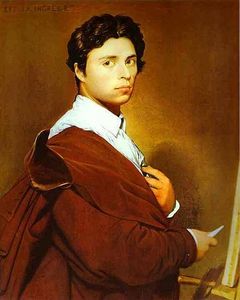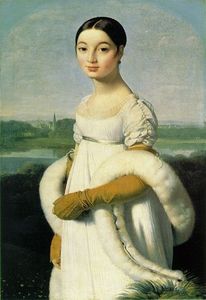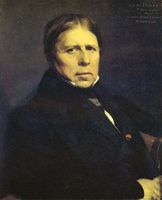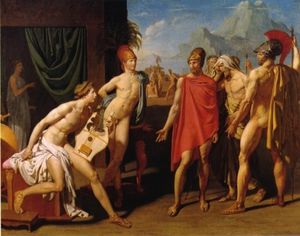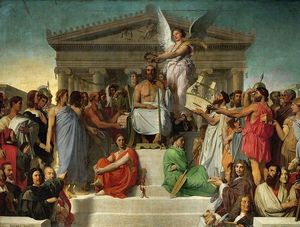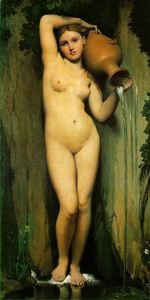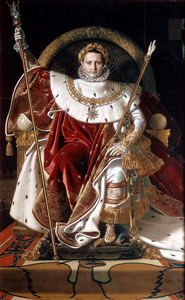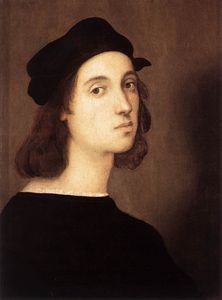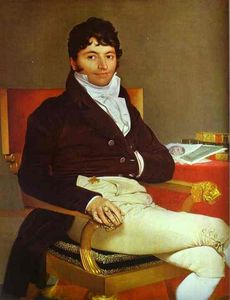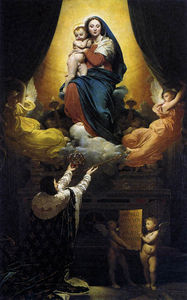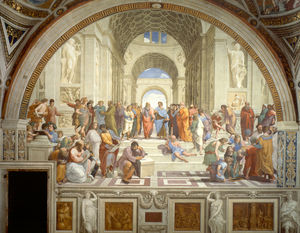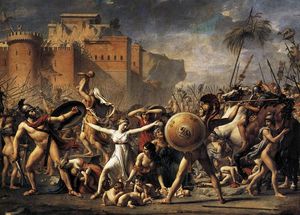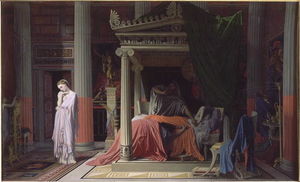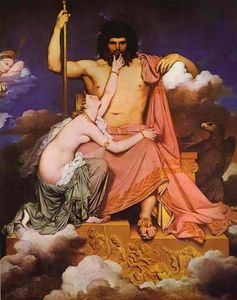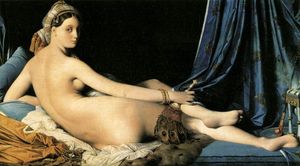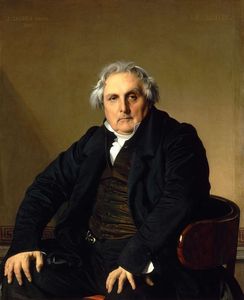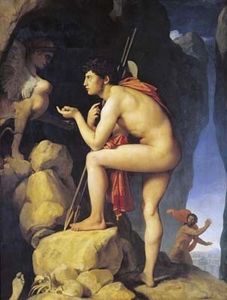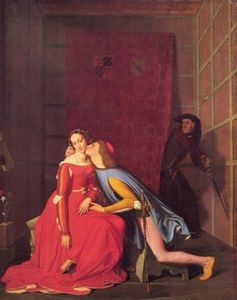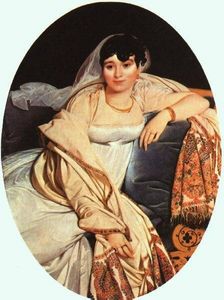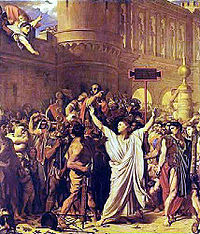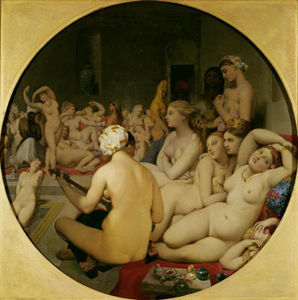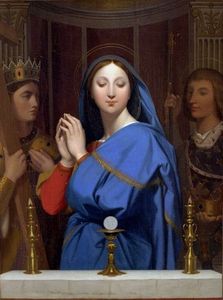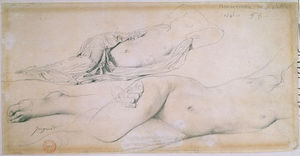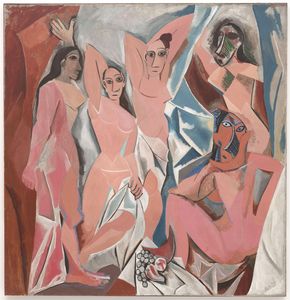Jean Auguste Dominique Ingres
- Full Name:
- Jean-Auguste-Dominique Ingres
- Short Name:
- Ingres
- Date of Birth:
- 29 Aug 1780
- Date of Death:
- 14 Jan 1867
- Focus:
- Paintings, Drawings
- Mediums:
- Oil, Wood
- Subjects:
- Figure, Fantasy, Scenery
- Art Movement:
- Neoclassicism
- Hometown:
- Montauban, France
- Jean Auguste Dominique Ingres Page's Content
- Introduction
- Artistic Context
- Biography
- Style and Technique
- Who or What Influenced
- Works
- Followers
- Critical Reception
- Bibliography
Introduction
The ups and downs of Jean-Auguste-Dominique Ingres' career are a most fascinating aspect of his artistic journey. During his 87 years he had frequently seen the critical response to his work go from unabashed scorning to enthusiastic accolades. This fluctuation literally occurred overnight after one Salon exhibition, but it was without significant longevity. Though the opinion of his worth as an artist was inconsistent the majority of his life, he ultimately finished on top. In his latter years he was well respected, highly sought after and even deemed the best living artist in France.
Ingres is credited as an icon of cultural conservatism in 19th century France. He is known for his obsessive quest for ideal beauty which resulted in his famous (or infamous) anatomical distortions. He was a respected portraitist and was commissioned to do work for the royal family.
Jean Auguste Dominique Ingres Artistic Context
Ingres is considered one of the last Neoclassical painters. When his life ended, so did the movement. Neoclassicism is the 18th century revival of classical beliefs. It differs from other revivals because the old interest was paired with new findings of both ancient worlds; Greece and Rome. The artifacts uncovered at Pompeii and Herculaneum contributed significantly to this rebirth of classicism.
Artists like Ingres portrayed the absolute truth of life as seen through the mirror of the "pure and simple" verities of antiquity. Neoclassicism replaced frivolity and superficiality of the Rococo era.
Jean Auguste Dominique Ingres Biography
There's no specific age to pinpoint when Ingres became interested in art. As his father was an artist, Ingres likely began training at an early age. His career experienced many ups and downs, but as a true Neoclassical artist, Ingres stayed true to the classical notion of idealized beauty.
Early Years:
He elevated to more formal training, moving to France then to Rome and back between the two places throughout his life. Ingres spent the majority of his early years following his own artistic impulses, thus being rejected almost entirely by the Salon's critic approval.
Intermediate Years:
The reaction to Ingres' art fluctuated during his middle years. He spent his time moving back and forth from Paris to Rome according to if he had a favorable response or not. Likewise, his critical reception went back and forth; in and out of his favor. Despite the fickle public, Ingres eventually became a well respected teacher.
Advanced Years:
In his latter years, Ingres continued to paint and shock his critics. He ultimately ended on top, being viewed as one of the greatest living artists in France during that time. He left behind many fans but no pupils to carry on the Neoclassicism legacy.
Jean Auguste Dominique Ingres Style and Technique
Though Ingres was an artist known to follow his own impulses he was still a devout student of cultural conservatism, never straying completely from Neoclassical's new but traditional beliefs. Ingres' cool, meticulously drawn works constituted the stylistic antithesis of the emotionalism and colorism of the contemporary romantic school.
Defining Characteristics:
Nudes:
Ingres was undoubtedly among the most experimental artists of the 20th century. His constant search for the idealized human form, particularly in the female body, was the cause for his highly controversial anatomical distortions. He made a habit of elongating backs, his nudes sometimes described by critics as "creatures not found in nature."
The exception was La Source, in which Ingres displayed his model body in much more realistic proportions. This canvas was highly praised but in his later years, Ingres returned again to drawing with anatomical manipulations in The Turkish Bath. His quest for idealization was unending.
Historical Paintings:
Ingres' first historical paintings were done in the troubadour style, echoing the idealized atmosphere of the Middle Ages. In Napoleon I on His Imperial Throne, derivatives of medieval and Byzantine prototypes are seen; rigidity, flatness and lack of modeling. Ingres was accused by critics of purposely taking art back to its primitive state. Still, typical to troubadour style, Ingres also painted with a minute and illusionistic description of detail and was praised for his historical accuracy.
Midway through his career Ingres adopted a more classical style after moving to Florence and studying the work of Raphael. His form and subject matter is more reflective of the Italian master's and his evolution as an artist is evident.
Portraits:
Though Ingres preferred history painting, he was also a well-known portraitist. In the sketches he'd drawn for tourists in his early years in Italy he portrayed an uncanny control of a delicate yet firm line and an inventiveness in posing sitters to reveal their personalities. He captured his figure with an impressive photographic likeness.
Years later, as the most sought-after portraitist in France, Ingres painted the grace and splendor oh his female elite sitters, again with photographic realism.
Color Palette:
As a student of David, Ingres was under the firm belief that more attention should be paid to the drawing of lines rather than color. Though insistent on this belief, no attention to detail, especially concerning fabrics, was lost when Ingres' colors brought his subjects to life.
Lighting:
Ingres' earlier works were attacked for a flatness resulting from a lack of conventional modeling. The artist continued to paint in such a fashion up until his later years. His attention to lighting can be seen in the fabrics of his most elite sitters.
Who or What Influenced Jean Auguste Dominique Ingres
Perhaps Ingres' earliest inspirations were from a man living under the very same roof as him; his father was an artist moderately skilled in various styles. Throughout the remainder of his life however, Ingres acquired an interest in the work of more well-known artists and artistic periods. The special attention Ingres paid to such different sources helped him accumulate an original and influential style while still staying true to Neoclassical beliefs.
Troubadour Style:
Early in his career Ingres demonstrated an interest in the troubadour style. Taking its name from medieval troubadours, this was a French artistic movement aiming to regain the idealized atmosphere of the Middle Ages. Ingres' earlier art reflected derivatives of medieval and Byzantine prototypes as seen in Napoleon I on His Imperial Throne. Critics have attacked the severity, flatness and lack of modeling that Ingres continued to use on and off during his career. Typical to troubadour style, Ingres also painted with a minute and illusionistic description of detail, specifically in his rendering of fabrics and other technical means.
Renaissance / Raphael:
Ingres took a particular liking to the classical style of Raphael. After moving to Florence, Ingres adopted a more conventional style similar to his hero's. Raphael's influence can be seen in The Vow of Louis XIII and The Apotheosis of Homer, commissioned for the ceiling of the Louvre. The Apotheosis is a variation on the Classical pattern of Raphael's The School of Athens, painted for the Vatican. Ingres considered School of Athens a doctrine on canvas of his artist beliefs but in true neoclassical form, he revisited all classical themes with a more modern, scientific approach.
Jacques-Louis David:
Ingres worked in the studio of David, a most celebrated artist during his day. David taught that the basis of art was the contour and so he can be held partly responsible for the excessive emphasis on drawing that characterized European academic painting in the 19th century. His influence can be seen in Ingres' work more so than earlier Neoclassical artists whose initial style was not much more different than Rococo. David was interested in narrative painting rather than ideal grace and this notion is clearly echoed by Ingres.
Jean Auguste Dominique Ingres Works
Jean Auguste Dominique Ingres Followers
Ingres's death marked the symbolic end of the tradition of monumental history painting in France. Despite having been surrounded by a group of devoted fans, Ingres left behind no pupils who would sustain his increasingly antiquated artistic vision. He was considered the last Neoclassical artist.
Twenty First Century Artists:
Exhibitions of Ingres' work are still widely popular. An ongoing scholarly fascination with his work proves him to have been a great and compelling artist of the 19th century.
Twentieth Century Artists:
Early in the 20th century Ingres came to be recognized as one of the major figures of early modern art. His linear lyricism and spatial and anatomical experimentation is known to have influenced the work of some of the greatest modern artists, namely Picasso.
Ingres's influence on Picasso can be seen throughout Picasso's career. Like Ingres, Picasso would create a world with a few lines of the pen, adding his colors after his design. One of Picasso's greatest additions to the art world, Cubism, was also influenced by Ingres. It is ironic to note that as Picasso was praised for Cubism, a resort to primitivism, Ingres was harshly rebuked by critics for his purposeful return to art's primitive state.
Ingres later became the subject of more mocking and ironic tributes by Surrealist and Post-Modernist artists.
The Impressionist:
Though Ingres' later fame came during the 20th century, Edgar Degas, of the late 19th century, derived inspiration directly from Ingres' work. Like Ingres, Degas studied at the Ecole des Beaux Arts before leaving for Italy for five years to focus on the Renaissance works of Italian art. The importance of the drawn line is the most notable influence of Ingres in Degas' work. Degas was insistent on the importance of classical draftsmanship, stressing balance and clarity of outline.
Jean Auguste Dominique Ingres Critical Reception
The work of Jean-Auguste-Dominique Ingres scaled the reactionary gamut when it came to critiques. During his 87 years he had frequently seen the critical response to his work go from unabashed scorning to enthusiastic accolades. The favor of his work was a swinging pendulum; not even he was certain what the reactions would be after he exhibited a piece to a Salon.
Contemporary Reception:
Critics expressed a strong distaste for his work when Ingres exercised experimental freedoms, that is, when he created things formerly unseen in art of his day. His frequent anatomical distortions in quest for ideal beauty supplied critics with an endless amount of ammunition. Though he was described as "hyper-sensitive" this didn't stop him following his own artistic impulses. He continued to explore his own originality even after being ridiculed for a lack of modeling, for bringing art back to its most primitive state (Jupiter and Thetis), and for conjuring up creatures unknown to nature (the elongated back of La Grande Odalisque) Still, he sometimes curbed his desire for the perfection of the female form, as in The Source. This taming brought about the praise of the masses.
Current Reception:
Today, Ingres is still viewed as a master of the 19th century. He continues to spark the interest of modern art critics and galleries of his work are in wide reception.
Jean Auguste Dominique Ingres Bibliography
Volumes have been written about Neoclassicism and Jean-Auguste-Dominique Ingres' contribution to this exciting movement. Below is a selection of some recommended works for further reading about this fascinating movement in art.
Books:
• Boime, Albert. Art in an Age of Bonapartism, 1800-1815. Chicago: Chicago University Press, 1993
• Fisher, Jay M. The Essence Of Line: French Drawings From Ingres To Degas. Pennsylvania: Pennsylvania State University Press, July, 2005
• Grimme, Karin H. Jean Auguste Dominique Ingres: Taschen Basic Art. New York: TASCHEN, December, 2006
• Symmons, Sarah. J. A. D. Ingres: The Apotheosis of Flaxman. The Burlington Magazine, Volume 121, Number 920.1979. 721-731
• Vigne, Georges. Ingres. London: Abbeville Press, Incorporated. October, 1995
Articles:
Kimmelman, Michael. The peculiar realism of Ingres. International Herald Tribune, March 31, 2006. Retrieved on November 1, 2008

